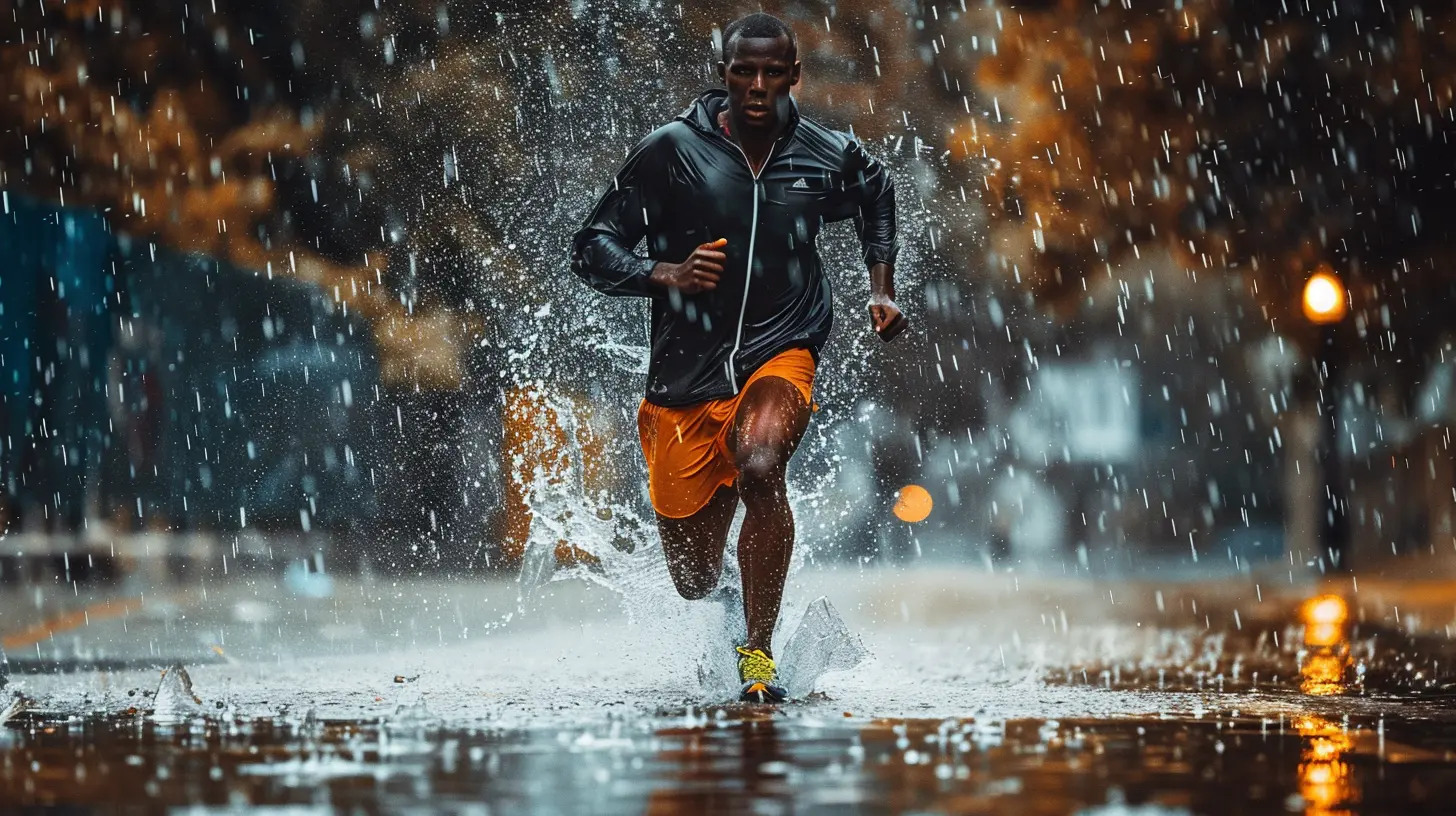Running in Extreme Weather: Tips for Staying Safe and Competitive
22 November 2025
Let’s face it—running is hard enough on a good day. But when Mother Nature decides to turn up the heat, blast us with icy winds, or open the heavens with a torrential downpour, it can feel downright impossible. Whether you're a beginner looking to keep up your routine or a seasoned runner aiming to stay race-ready, running in extreme weather takes more than just grit. It takes smarts, preparation, and a touch of stubbornness.
In this article, we’re diving deep into how to stay safe, strong, and even competitive when conditions are anything but ideal. From blistering heat to biting cold, we’ve got you covered (literally and figuratively). So tie those laces, grab a water bottle (or maybe a scarf), and let’s break this down.
Why Bother Running in Bad Weather?
Let’s get real for a second. Do you have to run in extreme conditions? Nope. But there’s something weirdly empowering about pushing through a snow-covered trail or conquering a sweat-drenched 5K in the midday sun.Running in tough conditions builds mental toughness, keeps your training on track, and honestly? It makes the perfect humblebrag for your next Instagram post. Just be smart about it. The goal is to challenge yourself—not end up in the ER.
The Risky Business of Extreme Weather Running
Before we get into the how-to, let’s talk about the risks. It’s important to recognize what you’re up against:- Heat stroke and dehydration in hot weather
- Hypothermia and frostbite in freezing temps
- Slips, falls, and visibility issues during rain or snowstorms
- Poor air quality during wildfires or smog
Sound fun? Not really. But with the right gear, mindset, and prep, you can minimize these dangers and still crush your goals.
Running in Hot Weather
Picture this: It’s 92°F, not a cloud in the sky, and your shoes feel like they’re glued to molten concrete. Running in heat isn’t just uncomfortable—it’s a game of survival.🔥 Tips for Running in the Heat
1. Run Early or Late
Try to avoid peak sun hours (10 AM to 4 PM). Those early morning runs feel cooler and are a great way to start your day. Late evenings work too—just bring reflective gear.2. Hydration is Your Best Friend
Drink water before, during, and after your run. For longer distances, bring an electrolyte drink or salt tablets to avoid hyponatremia (aka too little salt).3. Dress Like a Minimalist
Light, breathable, moisture-wicking clothes are key. Go for light colors to reflect sunlight. Don’t forget a hat and sunglasses.4. Slow It Down
This isn’t the time to set a PR. Your body works harder in the heat, so ease up on the pace and listen to your body.5. Know the Signs of Heat Illness
If you feel dizzy, nauseous, or chilled despite the heat—stop immediately. No run is worth your health.
Running in Cold Weather
Running in freezing temps is like winter camping with cardio. Sounds intense? It can be, but it’s also wildly rewarding.❄️ Tips for Running in the Cold
1. Layer Like an Onion
Layering is the name of the game. Start with a moisture-wicking base, add an insulating layer, and finish with a wind- or water-resistant shell. Bonus points if it’s reflective.2. Don’t Forget the Extremities
Hands, ears, nose, and toes—keep ’em covered. Frostbite is surprisingly sneaky. Wool socks, gloves, and ear warmers are your best friends.3. Warm Up Inside First
Do some dynamic stretches indoors before heading out. A warmer core means less shock when you hit the cold.4. Adjust Your Breathing
Cold air can make your lungs feel like you’ve just inhaled freezer burn. Try breathing through a buff or scarf to warm the air before it hits your lungs.5. Watch the Ground
Snow and ice turn your usual path into a booby trap. Go slow, run on fresh snow (it’s less slippery), and consider using traction cleats.Running in Rain and Wind
Running in the rain isn't just for movie montages and dramatic sports ads—it’s the real deal. And let’s not even talk about 30 mph wind gusts slapping you in the face on mile four.🌧️ Tips for Rainy or Windy Runs
1. Choose the Right Gear
A lightweight, waterproof jacket will save your life (or at least your skin). Wear a hat with a brim to keep rain out of your eyes. Avoid cotton—it stays wet and heavy.2. Protect Your Electronics
Stash your phone in a waterproof pouch or plastic baggie. There’s nothing worse than ending a soggy run to realize your phone drowned with your playlist.3. Prevent Chafing
Wet clothes mean more friction. Apply anti-chafe balm liberally—especially where seams hit skin.4. Use the Wind Strategically
If you’re doing an out-and-back route, run into the wind on the way out, so it helps push you home later. Trust me, you’ll thank future-you.5. Embrace the Mental Game
There’s something badass about finishing a run through sideways rain. Just be mindful of storms and lightning—if it’s dangerous, don’t risk it.Altitude, Smog, and Other "Fun" Conditions
Welcome to the wildcard category. Everything from high altitude to poor air quality can put a damper on your training.⛰️ Running at High Altitude
Less oxygen = harder runs. Ease into it with short, easy workouts, and give your body time to adapt. Hydration is even more important here.🌫️ Running in Poor Air Quality
If it smells like a bonfire or a chemical plant, don’t run outside. Use an air quality app and consider a treadmill or indoor track when AQI is above 100.General Safety Tips
Doesn't matter if it's hot, freezing, or somewhere in between—safety should always be top of mind.🦺 Be Seen
Always wear reflective gear or lights when visibility is low. Bright colors help cars spot you from afar.📱 Carry ID and Phone
In case of emergencies, you’ll want both. Use a running belt or armband that fits snugly.👟 Pick the Right Shoes
Traction matters. Trail shoes or ones with aggressive soles are great for slippery or rugged terrain.🧠 Listen to Your Body
Your body is your best coach. If things feel wrong, don’t tough it out. It’s not weakness—it’s survival instinct.Race Day in Extreme Conditions
Training is one thing. Racing in extreme weather? That’s a whole different beast.🏁 Strategy Over Speed
Stick to a conservative pacing strategy. You’ll make up for it by staying upright and finishing strong.🍌 Adjust Nutrition and Hydration
Weather changes how your body absorbs food and fluids. Plan your fuel accordingly and test during training.🧠 Mental Prep Is Key
You’ve trained for this—literally and mentally. Rehearse your response to discomfort or adverse conditions. Visualize success before the race begins.Staying Competitive Without Burning Out
It’s tempting to push hard no matter what. But in extreme weather, playing the long game is more important than short-term heroics.- Reframe success as "just showing up" in tough conditions.
- Track effort, not pace. Your GPS might say you’re slow, but your body knows you’re working harder.
- Prioritize recovery—extreme conditions are harder on your body than you think.
Final Thoughts: Embrace the Elements
Running in extreme weather isn’t for the faint of heart—but it is for those with heart. Every time you lace up despite the forecast, you're signing up for growth. You're proving to yourself that excuses don’t stand a chance against commitment.So whether it’s blazing sun, icy winds, pouring rain, or a combo of all three (thanks, spring), the next time the weather challenges you—rise to the occasion. Not just as a runner, but as someone who refuses to be stopped by a little discomfort.
After all, some of the greatest stories come from the toughest runs.
all images in this post were generated using AI tools
Category:
AthleticsAuthor:

Onyx Frye
Discussion
rate this article
1 comments
Zarenith McPhail
Great article! Staying informed about weather conditions is crucial for safety. I'd also recommend investing in moisture-wicking gear to prevent chafing and ensure hydration is prioritized, especially in extreme heat. Keep running safe!
November 22, 2025 at 4:57 AM


